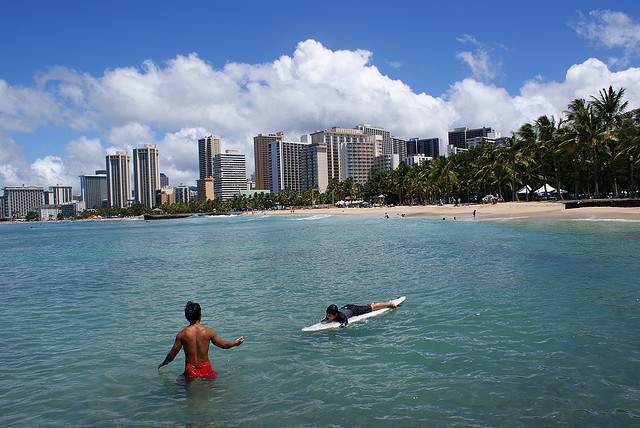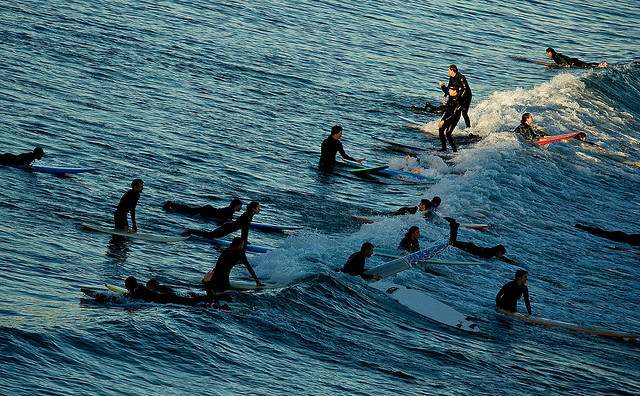No sport has quite as strong a sales pitch as surfing—a solitary rider dancing across the face of a glassy wave, seeming to master it in one moment and in danger of getting swallowed whole the next. This hard-sell is especially effective on the road, where people make a specific effort to try new things. Anyone who’s traveled for long stretches has at least been nibbled by the surf-bug and it’s become increasingly rare to meet a backpacker who hasn’t given it a shot once or twice. But what about those who really want to “get it,” who dream of carving a perfect bottom turn and long for the days when the feeling of a board under their arm is as natural as a backpack on their shoulders?
Those desires and a healthy mixture of love and respect for the ocean make a good jumping off point. The next step, whether you are already on the road or just in the planning stages, is to think about where to learn. The place that you choose can frame your entire experience and make all the difference in the world. Don’t you dare try to learn at Pipeline (sound ridiculous? It should), don’t try to learn at G-Land, Jeffery’s Bay, Trestles or Bells Beach either—if a wave is iconic, has a pro tour stop named after it or is mentioned wistfully in Point Break, it isn’t the place to start your surf career.
But don’t worry, there are plenty of spots that are perfect for beginners—here’s the list:
[social]
1 – Oahu, Hawaii, USA
Oahu is home to “The North Shore” a seven mile stretch of the best breaks in the world. Even rookies recognize names like Pipeline, Log Cabins, Sunset and Waimea—but those are spots that should be left to the rippers.
Beginners should look at Waikiki, the inside break at Haleiwa, Chuns Reef, Cockroach Bay and Puena Point. All five locations boast slow, rolling surf and locals who understand that many of the people in the water are just getting their feet wet.
>>book a cheap flight to Hawaii
2 – Kuta Beach, Bali, Indonesia
The tourist invasion has spoiled Kuta on many levels. The sand that used to be white is now grey, there is a very centrally located McDonalds, surf shops owned by Australians vastly outnumber local businesses. Still, the guesthouses are cheap, the waves at both Kuta and Legian are gentle (and even when they’re not they pile onto a sandy bottom) and you can definitely find plenty of likeminded beginners to push you in your progress.
>>look for Indonesia Airfare and read about the beaches in Indonesia
3 – New South Wales, Australia
Every state in Australia (excluding the Northern Territory, which isn’t one) has a few good options for learning to surf and hosts at least one world class break. It’s no surprise that the country has become as connected with surfing in the minds of travelers as Hawaii or California. For beginners landing at the airport in a fit to get going, New South Wales is likely to be the best choice. Bondi Beach, right in Sydney, is a sandy-bottomed break that is usually forgiving with learners.
Another favorite is Byron Bay, a longtime stopover for itinerant backpackers. The vibe in the water is just as friendly and welcoming as the vibe on land.
>>book flights to Sydney and read about the 6 Best Surfing Spots in Australia
4 – The Pacific Coast, Costa Rica
Costa Rica is getting more and more visitors who arrive with the specific intent of learning to surf. It is a land of surf camps, where boat-hire, instruction and professional photography are all readily available. The entire west coast is loaded with sandy, cruisy learning spots where many beginners catch their first wave. Dominical, Nosara and Jaco all have good starter waves with plenty beachside bars ideal for trading stories.
>>look for airfare to Costa Rica and book one of the surf hostels in Costa Rica
5 – Central & Southern California, USA
Seriously, you thought we’d forget? California is still a surfer’s paradise and can’t be ignored as a surf destination. And while the whole state has plenty of incredible surf spots, warmer water makes the central and south more ideal for those just starting to stand up.
In Central California, Santa Cruz’s Cowell’s is one of the planet’s most renowned beginner breaks. The wave is long and forgiving, with plenty of push to allow you to get to your feet. In Southern California shoot for Navy Street in Santa Monica, San Onofre, Doheney and Newport Pier in Orange County and Mission Beach in San Diego.
>>book a cheap flight to San Diego and also look for cheap hotels in San Diego
Tips for learning to surf on the road
If none of those spots are on your itinerary don’t worry, most countries with good waves have at least a few breaks that can accommodate beginners. Take the time to seek them out. Look for a wave that breaks onto a sandy bottom not a reef, has an easy take off point and is of manageable size. Finding a break that meets those pre-requisites will make learning easier and faster, but what’s even more important is taking the time to learn the right way. Some surfers learn faster than others because of natural talent, but more often than not it’s a matter of approach. Surfing takes some time to get a hang of—here are five tips for how to speed up the learning curve:
1 – Take Lessons
What this means is “take lessons from someone who knows how to teach, not just how to surf.” There’s a lot to learn from a good instructor and even after learning the fundamentals beginners can gain skill faster with someone keeping an eye on them and giving them detailed advice. Look for an instructor that you connect with, a program that has good equipment and a student-teacher ratio no higher than four to one. Every one of the spots listed above has reputable surf schools operating nearby.
2 – Choose the Right Board
Your first surfing experience could easily be derailed by having too small of a board. Rookies should start with a long board or a fun shape, something that will float you and allow you to feel the sensation of being propelled by the wave. It may also be a good idea to start out on a board that is soft on top.
Dustin Campbell, the General Manager of INT Softboards, says, “they’re made for safety and incredibly user friendly. Beginners aren’t going to get hurt riding them.” If you’re renting make sure that you know the damage policy and that you get a leash to go with the board.
3 – Learn the Right-Of-Way
Surfing has a natural set of rules, dictated by safety and the desire for everyone to have a good experience. The most crucial rule is that the surfer who is on their feet closest to the wave’s peak has right-of-way. Another way to put it is that if you are paddling and you see someone standing and coming down the line towards you, it’s your job to get out of the way.
You should 100% without-a-doubt learn how to be a courteous, polite surfer before you set foot in the water. This is particularly relevant for travelers, surfing at someone else’s home break. Defer to the locals, don’t try for every wave, smile, be friendly. Naturally, mistakes are bound to happen. If you do cut someone off a sincere apology goes a long way.
4 – Hold On
Surfing is by no means an inherently dangerous pastime, especially in the conditions that suit beginners. But still you have to keep your wits about you, be aware and consider others. One of the most important things you can do is hang onto your board. All too often inexperienced surfers see waves about to crash on them and dive under, leaving their board to drag behind (if they have a leash) or to go rocketing toward shore.
This can easily lead to injury and will definitely annoy every other person in the water. Instead, learn to duck dive or turtle roll right away, so that even if a big set comes in you won’t feel compelled to leave your board behind. For more info on the “do’s” and “don’ts” of courteous surfing visit www.surfinghandbook.com
5 – Have Fun
For most of us, surfing is a pastime. It is a diversion and meant to be a time to laugh, to reflect and to enjoy ourselves. Don’t get caught up in comparing yourself to other surfers or comparing your progress to that of other beginners in your class or group. Surfing, even when practiced by the ancient Hawaiians, was always something done just for the fun of it. Surf with that spirit in mind and you’ll find that people in the lineup will be friendly to you and willing to offer advice.
With that said…Welcome to the tribe!
About the author:
Steve Bramucci has surfed on six continents, tracking down waves from remote African islands to rock outcroppings in the Baja. He also covers the sport in his monthly column for Coast Magazine: The Diary of a Waterman.
Read more about:
- Five Unexpected Places to Learn to Surf
- Surfing Spots in Capetown
- 7 Wet and Wild Ways to Experience Costa Rica
Photo credits:
Waikiki by lawrence’s lenses on Flickr, Kuta, Bali by kalyan3 on Flickr, Bondi Beach by Ottoman42 on Flickr, Jaco by f-sosa on Flickr, Santa Cruz by anthony_goto on Flickr




